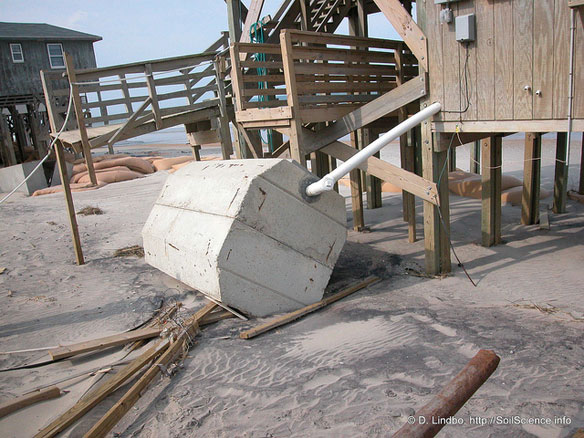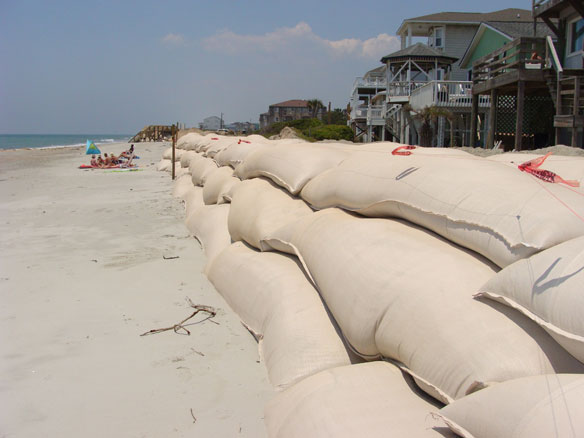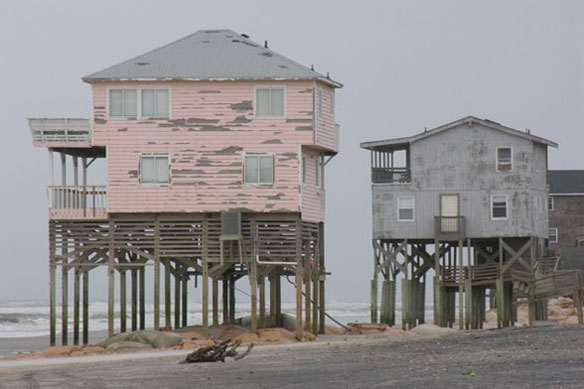
South Nags, NC. Photograph: © Orrin Pilkey / PSDS
By Orrin H. Pilkey, James B. Duke Professor Emeritus of Geology at Duke University.
More than a dozen science panels from coastal states around the country have projected a likely sea level rise of about 1 meter or more by 2100. But an increasingly effective sea level rise denier industry in this state, led by the NC-20 lobbying group and aided by the state legislature, has effectively blocked informing the public concerning the science of sea level rise.
A bill requiring that the future relationship between sea level rise and time be a straight line is becoming the butt of jokes around the globe. According to the UK’s Guardian newspaper, North Carolina is trying to wish away the sea level rise. Says Scott Huler in a Scientific American blog post, “North Carolina makes SLR illegal.”

Failed septic systems due to beach erosion at the Outer Banks of North Carolina. Captions and Photo source: ©© Soil Science
In the process of contradicting the scientific opinions of marine scientists around the country, NC-20 is imperiling the public. Projecting the future sea level rise may be complex, but we should heed or at least be allowed to listen to the warnings emanating from the many scientific studies. The general trend is very clear and very ominous.
It’s sort of like hurricane warnings. Although it’s difficult to predict the track and likely landfall more than a few days out, if a major hurricane is lurking off your coast, you had best make preparations now. If you wait until you know the precise spot of landfall, it may be too late to get out of harm’s way.
It is important that North Carolinians understand why scientists expect sea level rise to accelerate this century. The cause will largely be the melting of the world’s ice, contained in ice sheets (Greenland and Antarctica) and mountain glaciers.
The margins of both Greenland and the West Antarctic Ice Sheets are melting at a rapid rate. Beginning in 2010, the much larger East Antarctic Ice sheet showed a first-time (in the last two centuries) net loss of ice to the ocean. Future melting of Greenland ice will be more or less proportional to atmospheric temperature changes. The future of Antarctic ice melt, however, is more complex.
For example, an important cause of sea level rise (one that is difficult to predict) will be the behavior of the more than 50 floating ice shelves, large and small, that surround the edge of the Antarctic continent. These 200-to-400-meter-thick slabs of ice are holding back glaciers that move toward the sea from the continent’s interior. Recent studies show that most are thinning because warming ocean waters are melting their undersides and a warming atmosphere is melting their surfaces.
It is certain that some will break up, allowing the held-back glaciers to accelerate their flow to the sea. In 2002, the Larsen B ice shelf broke up, causing local glaciers to move seaward, but the sea level rise effect was negligible because that particular ice shelf was small.
The future of the Ronne-Filchner (California-size) and Ross (Texas-size) Ice Shelves is particularly troubling. Their break-up will have an immediate and large effect on sea level rise. A recent study by a British/German science team summarized in ScienceDaily.com suggests that the Ronne-Filchner Ice Shelf is becoming unstable because of thinning.
In the last few weeks, two other important studies of Antarctica have highlighted the potential sea level rise effect of melting. The first, by a University of Texas and British scientific team, based on satellite measurements and geophysical surveys, suggests that portions of the West Antarctic Ice Sheet are likely to increase their rate of melting soon. The second, from the British Antarctic Survey, notes that recently warming ocean water temperatures around the margin of West Antarctica (caused by changing ocean currents due to climate change) are primarily responsible for much of the melting ice currently occurring in West Antarctica.
Taken together, the evidence clearly supports the soundness of the North Carolina science panels’ projection of a minimal 1 meter sea level rise by 2100.
Now it’s time for the state government to back its scientific community and let the people know about the future facing their coast.

Rows of houses with overlapping sandbag walls create huge problems. The walls do as much damage to the beach as hardened seawalls. Removing the sandbags from one property potentially damages all of the others. Caption and photograph courtesy of: © Gary Lazorick









